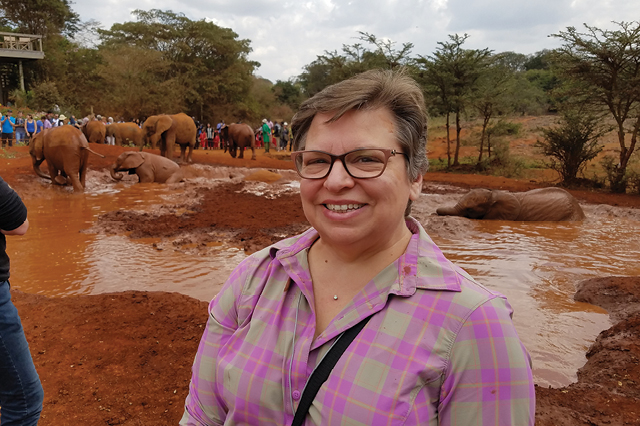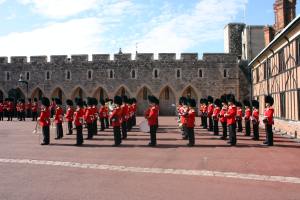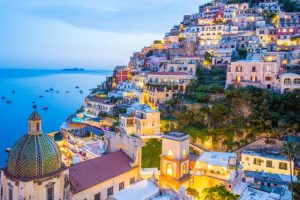Just like the lions and leopards she observed in the wildlife reserves of Kenya, Sue Cordeira’s desire to travel remains untamed.
Until about three years ago, she had not been far from her Dartmouth, Mass., home. For the previous eight years she had cared for her paralyzed husband and travel was too difficult. When he died in February 2016, she wanted to get away. She started at her nearest AAA branch. From there, she was off to Italy two months later.
Next was the U.K., then Costa Rica, Africa, Japan, U.S. national parks and the Pasadena Tournament of Roses Parade, all on tours she booked with AAA. One trip has led to another. She chose Costa Rica while on a tour of the U.K., because of a promotional video. She chose Africa while in Italy, because she saw another traveler’s photos. So far, the Kenyan safari has been her favorite.
She’s intent on seeing the world while she is still young – 54 years old.
“It’s important for people not to wait until retirement or until the kids are out of the house. Don’t wait until you’re too old to do it,” she said.
Some of the world’s most worthy destinations require physical endurance. She’s set out in the wee hours and settled in very late at night to spot exotic animals in Kenya, climbed steep terrain in Costa Rica and zip lined through its lush jungles.
She encourages others to follow her lead: “Go where you want to go. If it’s on your bucket list, just do it.”
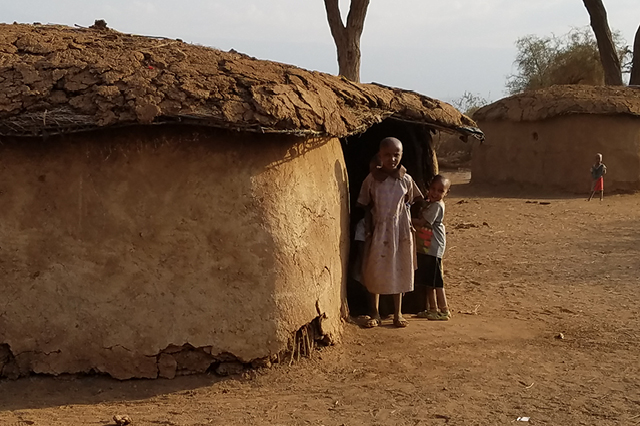
Being Part of the Experience
Cordeira has danced with Masai women in Kenya, stood almost side-by-side with an elk at the Grand Canyon and had a conversation about the Red Hot Chili Peppers with an umbrella salesman in Japan.
“That, to me, was the little experience that made the trip more memorable,” she said.
She believes immersing oneself in the culture of a destination is the best way to travel, and the tours she’s booked through AAA give her ample opportunity to do it.
In Africa, she was a welcomed guest at a Masai village.
“They live in mud huts, but they’re proud to show you their homes,” she said. “We tend to think they have very little, but we all want the same thing – to be happy – and they’re happy living their lives the way they do.”
It was also in Kenya that she ate barracuda – “It tastes like swordfish” – and goat curry – “there’s a lot of Indian influence there.” She was sprayed with muddy water by a baby elephant and licked across the face by a giraffe.
In Japan, while touring the Matsumoto Castle, she met a 15-year-old Japanese girl (now 16) who wanted to practice writing English. She asked if she could write to Cordeira in the United States.
“Now, I have a pen pal in Japan,” Cordeira said. “We write to each other about once a month.”
Traveling Solo – Sort Of
Cordeira has set out to see the world on her own, but still appreciates the company that comes with a group tour.
She’s been a solo traveler on all seven tours she’s booked through AAA since April 2016.
“People on tours welcome you. There are always people who want to scoop you up and bring you with them,” Cordeira said. “It’s a safe way to travel if you’re alone. People, especially women, should not be afraid to go alone.”
Cordeira has kept in contact with a few people she’s met along the way – fellow travelers, tour guides and her Japanese pen pal.
She said that, as a solo traveler, she develops a relationship with the people running the tours more so than other travelers, which allows for more customized experiences.
To be fair, Cordeira has taken trips completely on her own, too. She had just returned from Seattle early last fall when I caught up with her.
On an unusually clear day at the Space Needle’s observation deck, she was able to see Mount Rainier, about 67 miles away.
She admired the brilliant displays at the Chihuly Garden and Glass museum on her own. She visited Pike Place Market and delighted in some of the city’s quirky landmarks, like the Gum Wall, the Fremont Troll and Waiting for the Interurban, to name a few.
If you don’t know what those are, you really should visit Seattle.
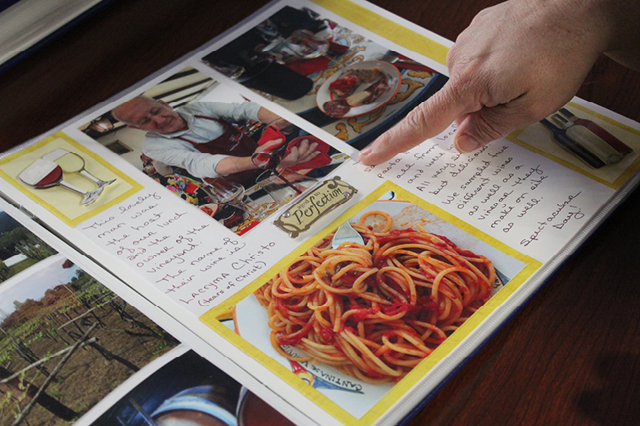
Volcanic Vineyards
A familiar aroma can have the amazing power to transport you to another time and place.
For Cordeira the scent of roses is linked to a vineyard at the base of Mount Vesuvius.
She’s seated outside. Before her, a tabletop of painted tiles is set with handcrafted pottery, and neat rows of grape vines form an expansive backdrop. Rose bushes at the end of each row bloom in earnest – a good sign for the coming harvest.
The roses gauge the quality of the crop, Cordeira said. “If the rose bush is dying, you know you have to do some adjustment to the soil, or else your grapes were going to die as well.”
The vineyard owner prepared a simple lunch of the freshest ingredients.
“Everything was from within that neighborhood,” Cordeira said. “The tomatoes for the sauce were from the guy down the street, the cheese was from the guy who had cows.”
Each dish was accompanied by a selection from the winery that is distinct for its grapes grown in the same ash that buried Pompeii in A.D. 79.
This is one of the lingering memories from Cordeira’s trip to Italy.
She cherished the close of each day, when she gathered with friends on a hotel balcony overlooking the Tyrrhenian Sea for snacks and the transfixing glow the sunsets cast on the colorful buildings hugging the cliffside.
It’s All Ancient History
On the tour of Rome and the Amalfi Coast, Cordeira visited the Vatican and the Sistine Chapel, the Colosseum, Pompeii and other notable historic places, and in between savored many delicious meals.
She was awed by the ancient architecture. “We tend to think of living in our area, going to Boston, that the buildings are very old,” Cordiera said. “Here, we’re talking 250 years ago; in Italy, we’re talking 2,000 years.”
“It’s crazy. When you’re at Pompeii, and you’re walking the grounds, and you look down at the rock roads, you can see the ruts from 2,000 years ago when the chariots went through,” she said.
She admired her surroundings not only for the history but for the beauty: the exquisite architecture of basilicas built with different colors of marble, intricate mosaics made up of many tiny tiles and awe-inspiring paintings, sculptures and other art.
Happy Cows Make Mozzarella
Happy cows are hilarious. Just ask Cordeira. They also produce more milk.
Those were some insights she gathered during a visit to a mozzarella factory in Italy where the Italian Mediterranean buffalo are so well taken care of that they actually have a spa.
“It’s funny as heck the way they designed it,” she said. “It’s not like a spa we think of. They have these areas of hay like mattresses where the cows can lie down. They have these big roller brushes that constantly rotate, so you will see a cow go over and get a back rub from the brush.
“They’re not forced to be milked. They’re not forced to do anything,” she said. “The cows know where to go to be milked, but they go when they want to go.”
Now she knows the secret behind the mouthwatering mozzarella she savored during many meals in Italy, along with the fresh pasta and produce that made up every delectable dish.
To Live Like the Romans
Cordeira wishes she could bring more of Italy’s lifestyle to the United States.
Italy is beautiful not only for the remains of ancient civilization, ornate architecture, exquisite art, breathtaking vistas and delicious cuisine. Its people and way of life are beautiful as well.
For Cordiera, there was no better example than the piazzas she strolled through during down time.
“You have this expansive area with gorgeous marble fountains and people walking around having gelato, or a slice of pizza, or grabbing an espresso, or sitting out at a restaurant having lunch with friends,” she said. “I wish we had more spaces like that, where you go with a community and hang out.”
Or be by yourself amid it all – sitting at the edge of a fountain reading a book, or, again, savoring gelato.
“The gelato was fantastic, very fresh. If you got something like a peach gelato, you felt like you were eating a fresh peach,” Cordeira said. “Things can be just simply done there but taste delicious because of the fresh ingredients.”
It was the same for the pasta she enjoyed at many meals. One of her most memorable dining experiences was at a place she deemed “a little touristy,” with strolling opera singers and a performance stage.
Given three choices of pasta dishes, she chose clams in red sauce. “If it’s pasta and clams, then that’s probably what I’m going to get, because that’s what I like.”
It was followed by a cake for dessert and cookies brought to the table, “and, of course, there was wine with everything.”
Amazing Africa
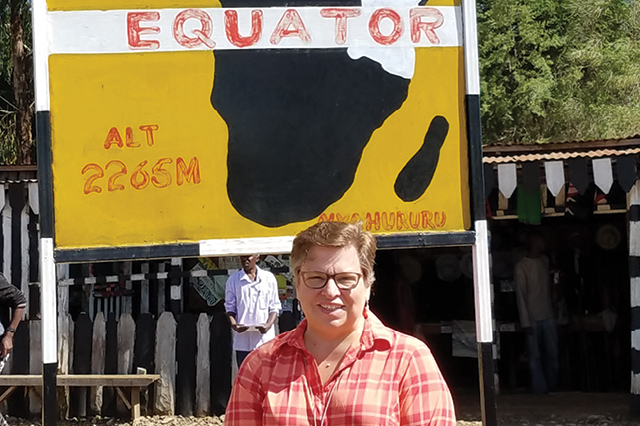
When the sun sets in vivid reds, yellows, oranges and colors you can’t quite describe across a vast horizon untouched by humans – that’s nirvana.
When you’re at peace amid the cacophony of wild animals – the screech of monkeys, the trumpet of an elephant, the roar of a lion – that’s paradise.
When you first spot one of the magnificent creatures of the African plains, “it’s like nothing you know,” according to Cordeira.
“Your heart starts beating faster, and you take a deep breath,” she said. “To see that first elephant come into view, you say, ‘oh my gosh. I can’t believe I’m seeing this.’
“I’m not religious, but I found it to be a very spiritual vacation,” Cordeira said about the safari tour of Kenya she booked through AAA.
Over the course of 15 days, Cordeira and a few others switched accommodations often between various reserves, each with a unique habitat, some lush and others dry.
They set out in small safari vans almost every morning and every evening, when the animals were most active.
“You’re in the safari van and the top pops up. Sometimes an elephant would be just 15 feet away,” she said.
Each surrounding offered an opportunity to see a particular species. “There’s only one reserve where you are going to see Grevy’s zebra,” the largest and most threatened of three types, she said.
No matter where they stayed, they were amid exotic animals. “It wasn’t unusual to see monkeys outside your door, baboons, warthogs … all running around. I’m sitting on my porch watching all of this going on.”
These are just some of the precious moments Cordeira will never forget.
Getting Ready for Safari
Packing was the hardest thing Cordeira had to do for her Kenyan safari vacation.
“We were allowed to bring only a 35-pound duffle bag,” said the AAA member from Dartmouth. “I suggest bringing sneakers or a comfortable pair of shoes that you don’t mind getting dirty – or even throwing away. I brought five outfits and hand-washed them as we went along.”
She needed clean clothes pretty often.
At the David Sheldrick Wildlife Trust elephant orphanage in Kenya, where she could touch elephant calves as they were bottle-fed, she underwent an “elephant baptism,” when she was doused with muddy water thrown from one animal’s trunk. She accepted it with the faithfulness of a true animal lover.
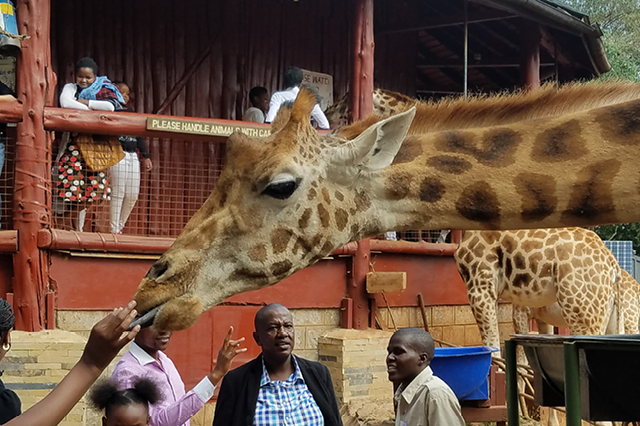
Animal Encounters
What was it like to pet an elephant? Kind of like petting a baked potato, according to Cordeira. That’s how she described the feel of their gray, dry, rough skin.
She saw elephants in their natural environments, too.
“I was amazed at how silent they are. For as big as an elephant is, the way they walk, they can sneak up on you,” she said.
Cordeira and the small group she was with on an African safari tour traveled in search of wildlife and reveled in their discoveries. With the help of expert guides with keen eyes, they spotted the continent’s elusive Big Five – lion, leopard, rhinoceros, elephant and cape buffalo – within the first three days of the trip.
When she heard a male lion’s roar as its pride settled for the night, “you could feel it in your chest.”
And, at a giraffe sanctuary, where she was able to feed the “majestic” creatures, one bent its long neck toward her and licked her across the face.
“I kissed a giraffe – and I liked it,” she joked.
Polite and Tidy in Tokyo
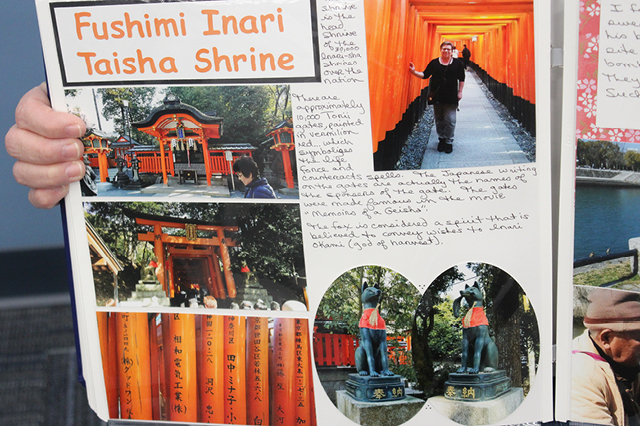
Cordeira has been to quite a few cities around the world in recent years – Rome, Paris, London, Nairobi and Seattle, to name just a few. Although each was beautifully unique, some things were the same: litter, unpleasant odors and loud, busy people with little regard for those around them.
That’s why, when she first stepped onto the streets of Tokyo, she was struck by how clean the city was, and its people so polite.
“You do not see a cigarette butt or gum on any street or sidewalk,” the AAA member from Dartmouth, Mass., said. “It’s part of the culture. They consider throwing trash on the ground offensive. … For as busy a place as it is, it’s not like being in New York City or Boston or any other city, because you don’t hear the blaring traffic, horns beeping, drivers swearing at other drivers … it’s just an incredibly polite society.”
It was the same on every stop she made during a 15-day tour of Japan from Tokyo to Kyoto. It was April, she could walk amid the famously gorgeous cherry blossoms, but that was a side attraction to many wonderful cultural experiences.
In Tokyo, she visited the geisha district and the ancient and architecturally stunning temple Senso-ji, the Imperial Palace and the Kokyo Gaien National Gardens. She was an honored guest at a Chado Tea Ceremony, which she considers one of the best parts of the trip.
“The host of the ceremony chooses the artwork he wants to display based on who’s coming to visit. He chooses the bowls he will use to prepare the tea, depending on who’s coming. He chooses the sweets that are going to be served based on the time of year,” Cordeira said, noting that it was spring, so everything was light and refreshing. “They want to make sure you have a beautiful experience. It’s done with a lot of thoughtfulness, a lot of mindfulness.”
It was far from the only beautiful experience she had in Japan.
Other highlights included the culturally fascinating fish markets, the impressive face of Mount Fuji, and most of all, the food. No matter where she went, no matter what she ate – from sushi to skewered chicken and Hida beef – the food was carefully prepared and artfully presented.
“Oh my god, the food – that was the best part of the vacation,” she said.
A Trip to Suit Her Tastes
If you’re one of those people who likes to take pictures of your food, you’d be very happy in Japan.
Cordeira’s scrapbook of her vacation there last March is filled with such photos.
“Anything you get, I don’t care which restaurant you go to, it’s beautifully prepared and beautifully presented,” she said. “It looked like artwork. You don’t want to eat it – it looks so beautiful.”
But she did eat, and she savored every delicious bite.
She was already a fan of sushi and sashimi when she booked the trip with AAA, and those dishes lived up to her expectations. Other regional specialties that she sampled on a tour from Tokyo to Kyoto were unexpected.
“One night we were in Hiroshima, and they have these little okonomiyaki places all over the place. It’s basically these pancake-like things. They put cabbage in it and simple ingredients on top of it. They put this special okonomiyaki sauce, and it’s done on one of those big grills that everybody sits around, and they cook it there for you.”
In Takayama, she sampled the prized Hida beef paired with a traditional rice wine. And in Kyoto, she dined at a traditional yakitori resaurant.
“Yakitori is grilled chicken, but for the most part it’s anything that’s on a skewer,” Cordeira said. “We had family style, and they just kept bringing stuff to the table … everything from chicken thighs, chicken breasts, chicken livers … any part of a chicken you could imagine was presented to us in some way or form.”
She tried it all.
“I enjoy different types of food,” Cordeira said. “There were people who didn’t want to try anything they’d never had before, which to me is so strange. If you’re going on vacation, you want to try the food of the culture that you’re in.”

In the Market for Umbrellas
Imagine a vacation so incredible that a news crew comes out to film it.
That actually happened to Cordeira.
The day that her tour group was to tour Mount Fuji turned out to be pretty special. A thick fog around the upper stations of Japan’s tallest mountain and holy site had dissipated to reveal a breathtaking view not seen in a long while.
“It was a particularly clear day, and there was just a beautiful view of the mountains. The news crews were there in the morning, so they could put it on the afternoon news,” Cordeira said.
It was an experience she will never forget, but it was far from the most impressive. At that point, she had already been to notable sites like the Imperial Palace and took in the amazing view from Tokyo Tower. She had been a guest at a traditional tea ceremony and savored the fresh and artfully prepared fish dishes one expects.
After all that, and still more to come, one thing that fascinated Cordeira the most was simply Japan’s open-air markets. She was particularly impressed by the Omicho Market, the country’s largest, with more than 200 stalls, and oldest, dating to the 1700s.
“I really enjoyed the fish markets, just to see the variety of things that people get. I just think they’re cool,” she said. “The main focus is on fish and fresh vegetables. They have other things, but the majority of it is the fish from the Sea of Japan.”
Among the other things for sale were the three umbrellas Cordeira purchased from a salesman with whom she shared an affinity for The Red Hot Chili Peppers.
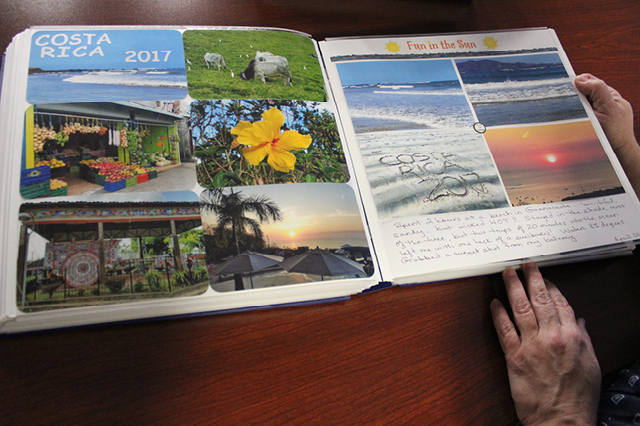
Colorful Costa Rica
They may call it a zip line “tour,” but Cordeira didn’t see much while gliding through the trees in Costa Rica – only because her eyes were closed most of the time as she held on for dear life.
She laughs about it now.
Standing on solid ground in the lush jungle areas was enough to gain a whole new perspective of the world.
When she booked the nine-day trip with AAA, Cordeira was looking for something unlike anything she’d ever done. Costa Rica delivered.
“You’re in a cloud forest, and you go to coffee plantations. There’s cruising on a river for a good part of the day, a beautiful beach, zip lining in a cloud forest … those kinds of things were all brand new for me,” she said.
She didn’t need a bird’s-eye view to notice the striking colors of the many tropical birds that surrounded her. Although she had some help from her tour manager.
“He knew his birds. He was pointing out all kinds. He knew flowers and plants and birds. He was super good with all of that kind of stuff,” Cordeira said.
There were monkeys, iguanas and caimans, too.
“There were lots of little things hanging out in the jungle, and the plants were weird. You’d have this big tree, and then hanging from the tree were little vines and then on the vine was another little plant that only lived on those vines. So, each tree would almost have its own little ecosystem going on,” she said.
“If I was just walking through that on my own, I wouldn’t notice, but having a tour manager who is from the area and loves his country and loves nature … that made it pretty neat.”
Start checking off your travel bucket list! Book your next trip with AAA Club Adventures.



